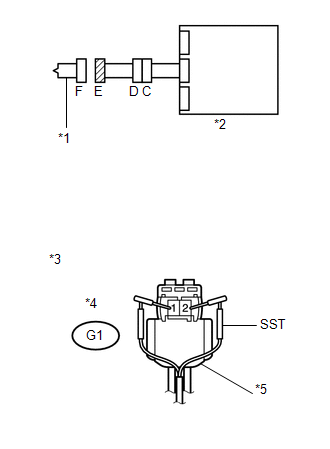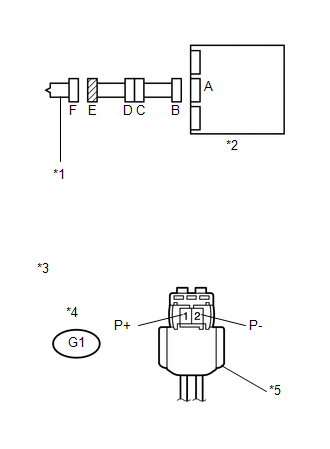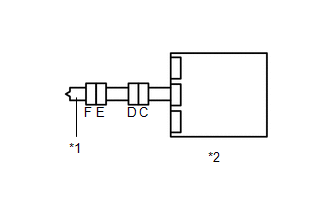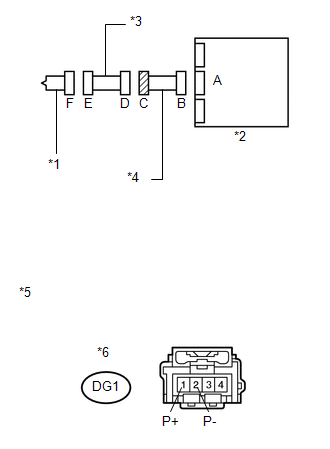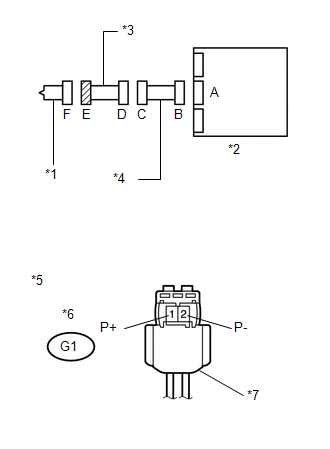Toyota Venza: Short in Front Passenger Side Squib Circuit (B1805/52-B1808/52)
DESCRIPTION
The front passenger side squib circuit consists of the center airbag sensor assembly and front passenger airbag assembly.
The center airbag sensor assembly uses this circuit to deploy the airbag when deployment conditions are met.
These DTCs are stored when a malfunction is detected in the front passenger side squib circuit.
|
DTC No. |
DTC Detection Condition |
Trouble Area |
|---|---|---|
|
B1805/52 |
|
|
|
B1806/52 |
|
|
|
B1807/52 |
|
|
|
B1808/52 |
|
|
WIRING DIAGRAM
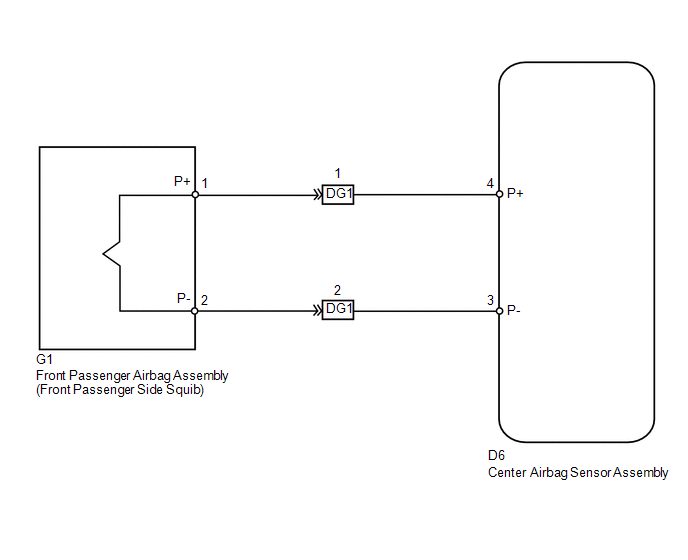
CAUTION / NOTICE / HINT
HINT:
- Perform the simulation method by selecting check mode (Signal Check)
using the Techstream (See page
.gif) ).
).
- After selecting check mode (Signal Check), perform the simulation method
by wiggling each connector of the airbag system or driving the vehicle on
a city or rough road (See page
.gif) ).
).
PROCEDURE
|
1. |
CHECK CONNECTORS |
|
(a) Turn the ignition switch off. |
|
(b) Disconnect the cable from the negative (-) battery terminal, and wait for at least 90 seconds.
(c) Check that the connectors are properly connected to the front passenger airbag assembly and center airbag sensor assembly. Also check that the connectors that link the instrument panel wire and instrument panel wire assembly are properly connected.
OK:
The connectors are properly connected.
HINT:
If the connectors are not connected securely, reconnect the connectors and proceed to the next inspection.
(d) Disconnect the connectors from the front passenger airbag assembly and center airbag sensor assembly. Also disconnect the instrument panel wire from the instrument panel wire assembly.
(e) Check that the terminals of the connectors are not damaged.
OK:
The terminals are not deformed or damaged.
(f) Check that the instrument panel wire assembly connector (on the front passenger airbag assembly side) is not damaged.
OK:
The lock button is not disengaged, or the claw of the lock is not deformed or damaged.
(g) Check that the short springs for the instrument panel wire and instrument panel wire assembly with the activation prevention mechanism are not deformed or damaged.
OK:
The short springs are not deformed or damaged.
Text in Illustration|
*1 |
Front Passenger Side Squib |
|
*2 |
Center Airbag Sensor Assembly |
|
*3 |
Instrument Panel Wire Assembly |
|
*4 |
Instrument Panel Wire |
| NG | .gif) |
REPLACE WIRE HARNESS |
|
|
2. |
CHECK FRONT PASSENGER AIRBAG ASSEMBLY (FRONT PASSENGER SIDE SQUIB) |
|
(a) Connect the instrument panel wire to the instrument panel wire assembly and center airbag sensor assembly. |
|
(b) Connect SST (resistance 2.1 Ω) to connector E (orange connector).
CAUTION:
Never connect an electrical tester to the front passenger airbag assembly (front passenger side squib) for measurement, as this may lead to a serious injury due to airbag deployment.
NOTICE:
- Do not forcibly insert SST into the terminals of the connector when connecting.
- Insert SST straight into the terminals of the connector.
SST: 09843-18061
(c) Connect the cable to the negative (-) battery terminal.
(d) Turn the ignition switch to ON, and wait for at least 60 seconds.
(e) Clear the DTCs stored in memory (See page
.gif) ).
).
(f) Turn the ignition switch off.
(g) Turn the ignition switch to ON, and wait for at least 60 seconds.
(h) Check for DTCs (See page .gif) ).
).
OK:
DTCs B1805, B1806, B1807, B1808 or 52 is not output.
HINT:
Codes other than DTCs B1805, B1806, B1807, B1808 and 52 may be output at this time, but they are not related to this check.
Text in Illustration|
*1 |
Front Passenger Side Squib |
|
*2 |
Center Airbag Sensor Assembly |
|
*3 |
Front view of wire harness connector (to Front Passenger Airbag Assembly) |
|
*4 |
Connector E |
|
*5 |
Color: Orange |
| OK | .gif) |
REPLACE FRONT PASSENGER AIRBAG ASSEMBLY |
|
|
3. |
CHECK FRONT PASSENGER SIDE SQUIB CIRCUIT |
|
(a) Turn the ignition switch off. |
|
(b) Disconnect the cable from the negative (-) battery terminal, and wait for at least 90 seconds.
(c) Disconnect SST from connector E.
(d) Disconnect the instrument panel wire from the center airbag sensor assembly.
(e) Check for a short to B+ in the circuit.
(1) Connect the cable to the negative (-) battery terminal.
(2) Turn the ignition switch to ON.
(3) Measure the voltage according to the value(s) in the table below.
Standard Voltage:
|
Tester Connection |
Switch Condition |
Specified Condition |
|---|---|---|
|
G1-1 (P+) - Body ground |
Ignition switch ON |
Below 1 V |
|
G1-2 (P-) - Body ground |
Ignition switch ON |
Below 1 V |
(f) Check for an open in the circuit.
(1) Turn the ignition switch off.
(2) Disconnect the cable from the negative (-) battery terminal, and wait for at least 90 seconds.
(3) Measure the resistance according to the value(s) in the table below.
Standard Resistance:
|
Tester Connection |
Condition |
Specified Condition |
|---|---|---|
|
G1-1 (P+) - G1-2 (P-) |
Always |
Below 1 Ω |
(g) Check for a short to ground in the circuit.
(1) Measure the resistance according to the value(s) in the table below.
Standard Resistance:
|
Tester Connection |
Condition |
Specified Condition |
|---|---|---|
|
G1-1 (P+) - Body ground |
Always |
1 MΩ or higher |
|
G1-2 (P-) - Body ground |
Always |
1 MΩ or higher |
(h) Check for a short in the circuit.
(1) Release the activation prevention mechanism built into connector B (See page
.gif) ).
).
(2) Measure the resistance according to the value(s) in the table below.
Standard Resistance:
|
Tester Connection |
Condition |
Specified Condition |
|---|---|---|
|
G1-1 (P+) - G1-2 (P-) |
Always |
1 MΩ or higher |
(i) Restore the released activation prevention mechanism of connector B to the original condition.
Text in Illustration|
*1 |
Front Passenger Side Squib |
|
*2 |
Center Airbag Sensor Assembly |
|
*3 |
Front view of wire harness connector (to Front Passenger Airbag Assembly) |
|
*4 |
Connector E |
|
*5 |
Color: Orange |
| NG | .gif) |
GO TO STEP 5 |
|
|
4. |
CHECK CENTER AIRBAG SENSOR ASSEMBLY |
|
(a) Connect the connectors to the front passenger airbag assembly and center airbag sensor assembly. |
|
(b) Connect the cable to the negative (-) battery terminal.
(c) Turn the ignition switch to ON, and wait for at least 60 seconds.
(d) Clear the DTCs stored in memory (See page
.gif) ).
).
(e) Turn the ignition switch off.
(f) Turn the ignition switch to ON, and wait for at least 60 seconds.
(g) Check for DTCs (See page .gif) ).
).
OK:
DTC B1805, B1806, B1807, B1808 or 52 is not output.
HINT:
Codes other than DTCs B1805, B1806, B1807, B1808 and 52 may be output at this time, but they are not related to this check.
Text in Illustration|
*1 |
Front Passenger Side Squib |
|
*2 |
Center Airbag Sensor Assembly |
| OK | .gif) |
USE SIMULATION METHOD TO CHECK |
| NG | .gif) |
REPLACE CENTER AIRBAG SENSOR ASSEMBLY |
|
5. |
CHECK INSTRUMENT PANEL WIRE |
|
(a) Disconnect the instrument panel wire assembly from the instrument panel wire. |
|
(b) Check for a short to B+ in the circuit.
(1) Connect the cable to the negative (-) battery terminal.
(2) Turn the ignition switch to ON.
(3) Measure the voltage according to the value(s) in the table below.
Standard Voltage:
|
Tester Connection |
Switch Condition |
Specified Condition |
|---|---|---|
|
DG1-1 (P+) - Body ground |
Ignition switch ON |
Below 1 V |
|
DG1-2 (P-) - Body ground |
Ignition switch ON |
Below 1 V |
(c) Check for an open in the circuit.
(1) Turn the ignition switch off.
(2) Disconnect the cable from the negative (-) battery terminal, and wait for at least 90 seconds.
(3) Measure the resistance according to the value(s) in the table below.
Standard Resistance:
|
Tester Connection |
Condition |
Specified Condition |
|---|---|---|
|
DG1-1 (P+) - DG1-2 (P-) |
Always |
Below 1 Ω |
(d) Check for a short to ground in the circuit.
(1) Measure the resistance according to the value(s) in the table below.
Standard Resistance:
|
Tester Connection |
Condition |
Specified Condition |
|---|---|---|
|
DG1-1 (P+) - Body ground |
Always |
1 MΩ or higher |
|
DG1-2 (P-) - Body ground |
Always |
1 MΩ or higher |
(e) Check for a short in the circuit.
(1) Release the activation prevention mechanism built into connector B (See page
.gif) ).
).
(2) Measure the resistance according to the value(s) in the table below.
Standard Resistance:
|
Tester Connection |
Condition |
Specified Condition |
|---|---|---|
|
DG1-1 (P+) - DG1-2 (P-) |
Always |
1 MΩ or higher |
|
*1 |
Front Passenger Side Squib |
|
*2 |
Center Airbag Sensor Assembly |
|
*3 |
Instrument Panel Wire Assembly |
|
*4 |
Instrument Panel Wire |
|
*5 |
Front view of wire harness connector (to Instrument Panel Wire Assembly) |
|
*6 |
Connector C |
| NG | .gif) |
REPLACE INSTRUMENT PANEL WIRE |
|
|
6. |
CHECK INSTRUMENT PANEL WIRE ASSEMBLY |
|
(a) Check for a short to B+ in the circuit. (1) Connect the cable to the negative (-) battery terminal. (2) Turn the ignition switch to ON. (3) Measure the voltage according to the value(s) in the table below. Standard Voltage:
|
|
(b) Check for an open in the circuit.
(1) Turn the ignition switch off.
(2) Disconnect the cable from the negative (-) battery terminal, and wait for at least 90 seconds.
(3) Measure the resistance according to the value(s) in the table below.
Standard Resistance:
|
Tester Connection |
Condition |
Specified Condition |
|---|---|---|
|
G1-1 (P+) - G1-2 (P-) |
Always |
Below 1 Ω |
(c) Check for a short to ground in the circuit.
(1) Measure the resistance according to the value(s) in the table below.
Standard Resistance:
|
Tester Connection |
Condition |
Specified Condition |
|---|---|---|
|
G1-1 (P+) - Body ground |
Always |
1 MΩ or higher |
|
G1-2 (P-) - Body ground |
Always |
1 MΩ or higher |
(d) Check for a short in the circuit.
(1) Release the activation prevention mechanism built into connector D (See page
.gif) ).
).
(2) Measure the resistance according to the value(s) in the table below.
Standard Resistance:
|
Tester Connection |
Condition |
Specified Condition |
|---|---|---|
|
G1-1 (P+) - G1-2 (P-) |
Always |
1 MΩ or higher |
|
*1 |
Front Passenger Side Squib |
|
*2 |
Center Airbag Sensor Assembly |
|
*3 |
Instrument Panel Wire Assembly |
|
*4 |
Instrument Panel Wire |
|
*5 |
Front view of wire harness connector (to Front Passenger Airbag Assembly) |
|
*6 |
Connector E |
|
*7 |
Color: Orange |
| OK | .gif) |
USE SIMULATION METHOD TO CHECK |
| NG | .gif) |
REPLACE INSTRUMENT PANEL WIRE ASSEMBLY |
 Short in Driver Side Squib Circuit (B1800/51-B1803/51)
Short in Driver Side Squib Circuit (B1800/51-B1803/51)
DESCRIPTION
The driver side squib circuit consists of the center airbag sensor assembly,
spiral cable and steering pad.
The center airbag sensor assembly uses this circuit to deploy the airbag whe ...
 Short in Driver Side Squib 2nd Step Circuit (B1810/53-B1813/53)
Short in Driver Side Squib 2nd Step Circuit (B1810/53-B1813/53)
DESCRIPTION
The driver side squib 2nd step circuit consists of the center airbag sensor assembly,
spiral cable and steering pad.
The center airbag sensor assembly uses this circuit to deploy the a ...
Other materials about Toyota Venza:
Calibration
CALIBRATION
1. SELECT COMPASS DISPLAY MODE
(a) The AUTO switch allows selection of the compass display.
2. PERFORM CALIBRATION
(a) Because each vehicle has its own magnetic field, calibration should be performed.
The calibration function is used to compe ...
Removal
REMOVAL
PROCEDURE
1. REMOVE ROOF DRIP CENTER SIDE FINISH MOULDING (w/o Sliding Roof)
(a) Put protective tape around the roof drip center side finish moulding.
Text in Illustration
*1
Protective Tape
...
Data List / Active Test
DATA LIST / ACTIVE TEST
1. DATA LIST
HINT:
Using the Techstream to read the Data List allows the values or states of switches,
sensors, actuators and other items to be read without removing any parts. This non-intrusive
inspection can be very useful bec ...
0.1311

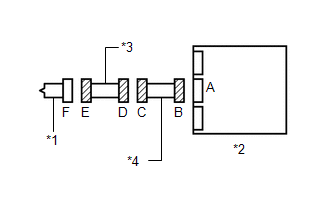
.gif)
